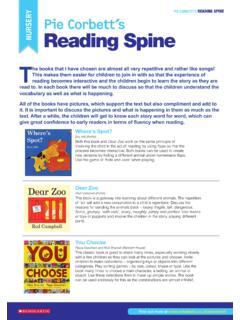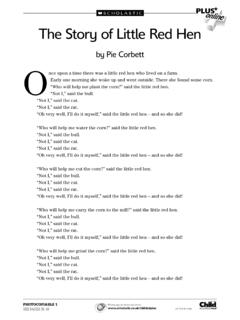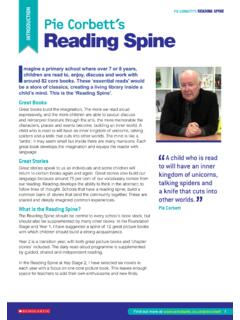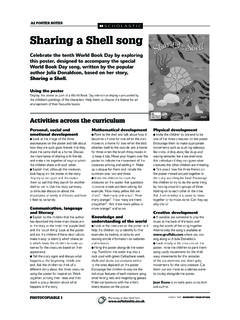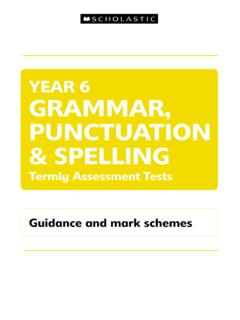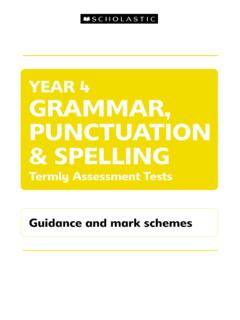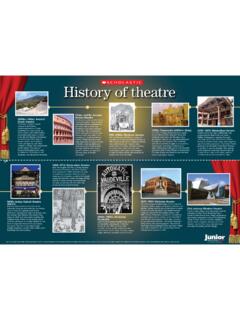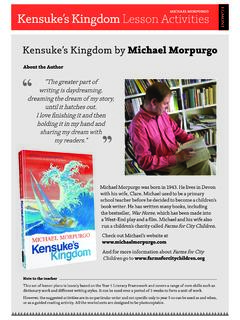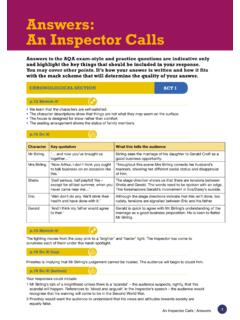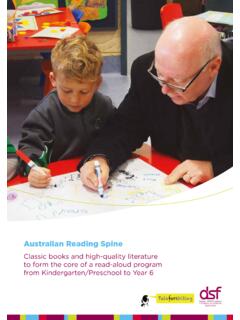Transcription of YEAR 2 Pie Corbett’s Reading Spine - Scholastic
1 PIE corbett 'S Reading Spine . year 2. Pie corbett 's Reading Spine I. n year 2, it is important to start to move from sharing picture books into sharing chapter books. These will not only provide a meaty read, but also demand that the children use their imagination. Of course, there are also many Reception and year 1 children who will sit and enjoy a chapter book and this should form part of their Reading experience. Many of the chosen books operate on different levels - from the satisfaction of good stories to the exploration of deeper themes. Traction Man is Here Picture books Mini Grey (Random House). With the class read the pictures carefully, looking for details. Discuss together any difficult words. Re-read a number of times and talk about how the characters feel. Bring into school other kitchen equipment and encourage children to invent further adventures for Traction Man and Scrubbing Brush.
2 Ask: Are the adventures real? Who made them up? Design Traction Man adverts or invent a new superhero or heroine. Meerkat Mail Emily Gravett (Macmillan). Begin by finding out a bit about meerkats and the other animals, such as jackals. Watch meerkats on film with the class. Invite the children to write a newspaper article about Sunny's visit to one of the places in the book. Encourage them to write postcards from other visits that he made. Together draw a map of the story. Also, read Wolves (Macmillan) and Little Mouse's Big Book of Fears (Macmillan). Amazing Grace Mary Hoffman (Frances Lincoln). With the class tell or read the stories mentioned: Joan of Arc, Anansi, The Wooden Horse, Hannibal, Treasure Island, Hiawatha, Mowgli, Aladdin and Dick Whittington. Ask: What sort of person is Grace? Where are the clues? In the story, are Raj and Natalie right? Which is the most important line in the story?
3 (Possibly you can be anything'.) (See the Read & Respond title for further ideas.). Find out more at PIE corbett 'S Reading Spine . year 2. Pumpkin Soup Helen Cooper (Corgi). Read and enjoy the images and story. Ask the children: What causes the argument and who was right? Discuss how Cat and Squirrel's feelings change. Ask: When are they happiest and why? In role as Duck, tell the story of what happened when you left the Pumpkin. Also, with the class set the story to music, perform and dance with costumes and chant or sing with a dramatic chorus. Who's Afraid of the Big Bad Book? Lauren Child (Orchard Books). Before Reading this book it is essential to know the stories of Goldilocks, Rapunzel, Dick Whittington and Cinderella so start by retelling these stories or some of the wit will be lost! Having really discussed the book, encourage the children to try falling into a book' and becoming a character in a well-known fairy tale, but then alter what happens.
4 Take photos, enlarge and copy these for the children. Then, ask the children to draw characters and objects onto the photos, using Lauren Child's collage technique. Dr Xargle's Book of Earthlets Tony Ross (Andersen Press). Read and enjoy then discuss the funny bits. Ask: What makes them amusing? As a class collect some of the strange words that Dr Xargle uses and give them definitions, such as eggmangle', earthlet', hairdo of a sheep'. Ask: What other strange things might aliens not understand if they came to earth? Together make a little book of such misunderstandings. Not Now Bernard David McKee (Andersen Press). Re-read a number of times and then discuss the parents, the child and the monster. Ask: Who in the story is naughty? Are the parents ignoring the child or is he choosing the wrong moment? Are they too busy? Are they kind parents? What does the monster stand for? When do we feel or behave like monsters?
5 Let the children take it in turn to role play being Mum and Dad and talk about what has happened in the kitchen! Find Find out out more more atat PIE corbett 'S Reading Spine . year 2. Tuesday David Wiesner (Andersen Press). After Reading ask the children: What do the frogs remind you of on the leaves? (Flying saucers.) Hot-seat the man at Ask: Why do the frogs fall off the leaves? Why is the last frog looking grumpy? Then turn the opening pages into a story. As the detective, encourage the children to interview the man in pyjamas and write up a police report. Together role play the news report and make a film of the interview and news item. Ask: What happens the next Tuesday at The Flower John Light (Child's Play). Before Reading ask the class: From the cover what might the book be about? How do the city people feel at the start of the book? Pause on the page in the library and see what the children notice.
6 Ask: Why might books be dangerous? Why might a book be labelled do not read'? Discuss the two books mentioned in the border: Jack and the Beanstalk' and Alice in Wonderland. Ask: What do they have in common and how do they differ? Why were they chosen? Stop where Brigg is Reading the book and discuss what the book is about. Ask: Why does he read it in secret? Then read straight through and discuss the theme again at the end of the book. Gorilla Anthony Browne (Walker Books). Read through the story and discuss. Re-read and look more carefully at the pictures. With the class make a list of strange things. Discuss the Dad and the Girl. Ask: What do they want? Talk about their relationship. Ask: Who is the gorilla? If you had to say what the book was about in one word, what word would you choose? Which is the most important picture and why? (See Read & Respond title for further ideas.). Emily Brown and The Thing Cressida Cowell (Orchard Books).
7 I would start this by bringing in a cuddly' and discussing why they are so important! Also, provide other Emily Brown' books for free Reading , including That Rabbit Belongs to Emily Brown (Orchard Books). On the first Reading , stop on the page where Emily asks, What's really the matter? and predict. Re-read and discuss the challenging vocabulary provide pictures and relate words to children's own experiences, listing synonyms. Tell a story that Emily might have told the witches and discuss the use of the font changes. Discuss what the story is about especially the end. With the class make lists of nice/scary things and write as list poems. Find Find out out more more atat PIE corbett 'S Reading Spine . year 2. Frog and Toad Together Novels Arnold Lobel (HarperCollins). Each of the five stories is a little gem. Here are some simple ideas for each tale: 1. Prepare model making lists with the class of what needs to be done and have children make job lists'.
8 2. Grow seeds: choose stories, poems, songs and play music for the seeds. 3. Bake cookies and discuss the need for will power'. 4. List brave characters for stories and discuss what it means to be brave. 5. What does the dream story mean? Finally, ask: What do the stories tell us about the different characters of Frog and Toad? Read through and list clues. Ask: Why would they make good friends? Which is your favourite story and why? Also, read Frog and Toad are Friends (HarperCollins). The Owl Who Was Afraid of the Dark Jill Tomlinson (Puffin). List and discuss fears about the dark saying: you are only afraid of the dark because you don't know about it. Role play Plop talking with the different characters. Write a letter to Plop to persuade him that the dark is actually friendly. Use an image of an owl (or the real thing if available) and draw in your nature sketch book'. Ask: How has Plop changed by the end?
9 Write list poems about the dark. Find out about other nocturnal animals and create constellations. Paint and create owl collages and masks. Revisit Owl Babies (Walker Books). (See the Read & Respond title for further ideas.). The Giraffe, the Pelly and Me Roald Dahl (Puffin). This is a meaty read. Begin by finding out a bit about giraffes, pelicans and monkeys. Invite the class to write adverts for The Ladderless Window Cleaning Company' and invent names for new sweets. Discuss the final song and its meaning. Draw The Grubber'. Ask: What dreams would you have? Learn, sing (or chant) and perform the various songs with the class. (See the Read &. Respond title for further ideas.). Fantastic Mr Fox Roald Dahl (Penguin). Before Reading , it might be worth finding out a little about foxes. Draw the three farmers and collect information/quotes about them from the book. Re-read and savour the great writing in Chapter 3.
10 Invite children to write letters to the farmers from the crowd at the end of chapter 7. Before Reading Chapter 9 ask: What do you think Mr Fox's plan will be? Pause in Chapter 12 and ask: Are the other animals right? Pause in Chapter 14 and ask: Is stealing right in this case? Discuss with the children whether farmers should shoot foxes. Then with the class role play the conversation between the farmers at the end. (See the Read & Respond title for further ideas.). Find Find out out more more atat PIE corbett 'S Reading Spine . year 2. The Hodgeheg Dick King-Smith (Puffin). Introduce the book by showing film/images of hedgehogs and discussing the problem they have with roads! Make a list of rules about crossing the road for Max. Ask: What advice would you give Max about crossing the road? Write sentences that swap over words and letters. Role play a family discussion about Max's condition in Chapter 4.
